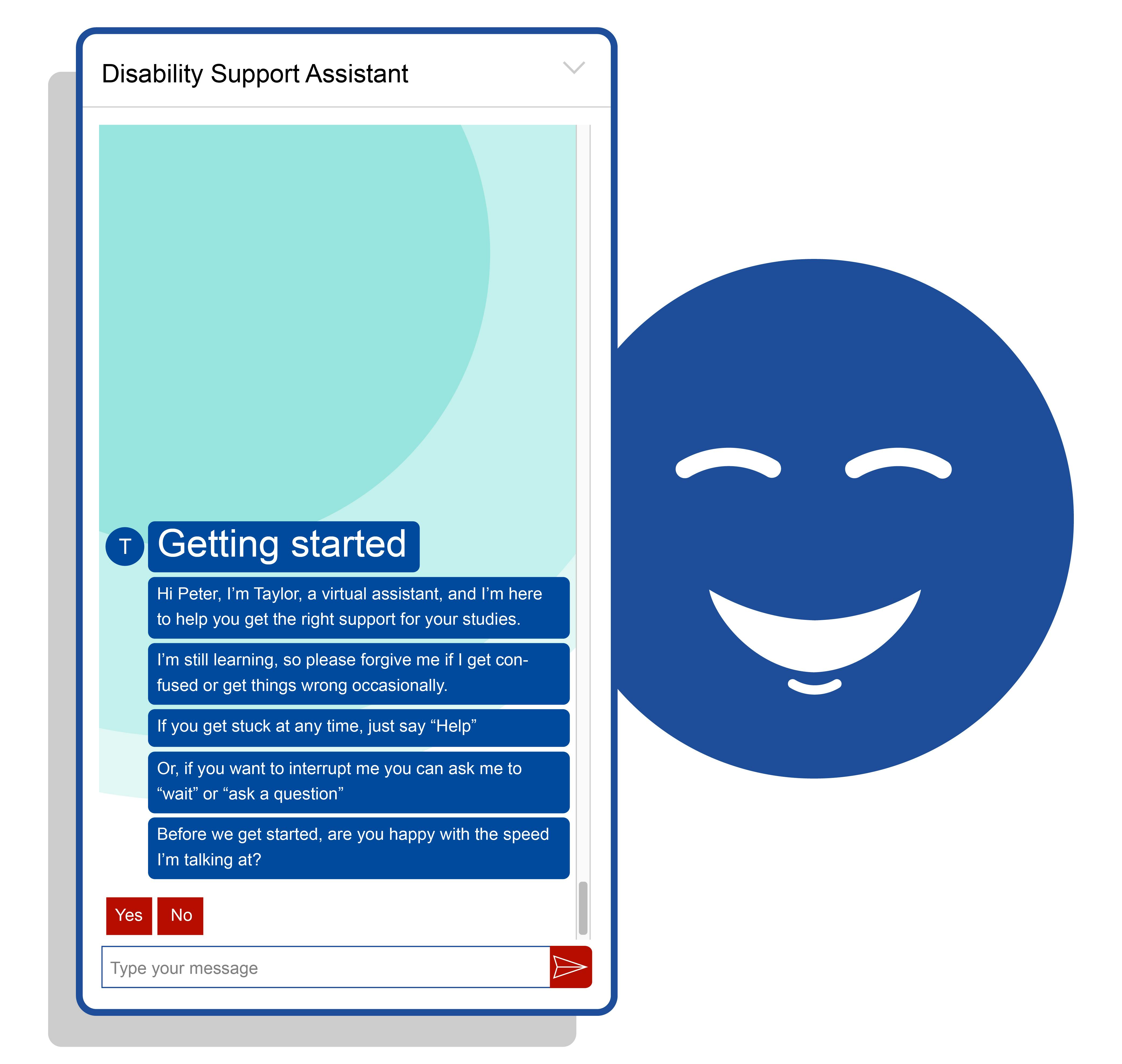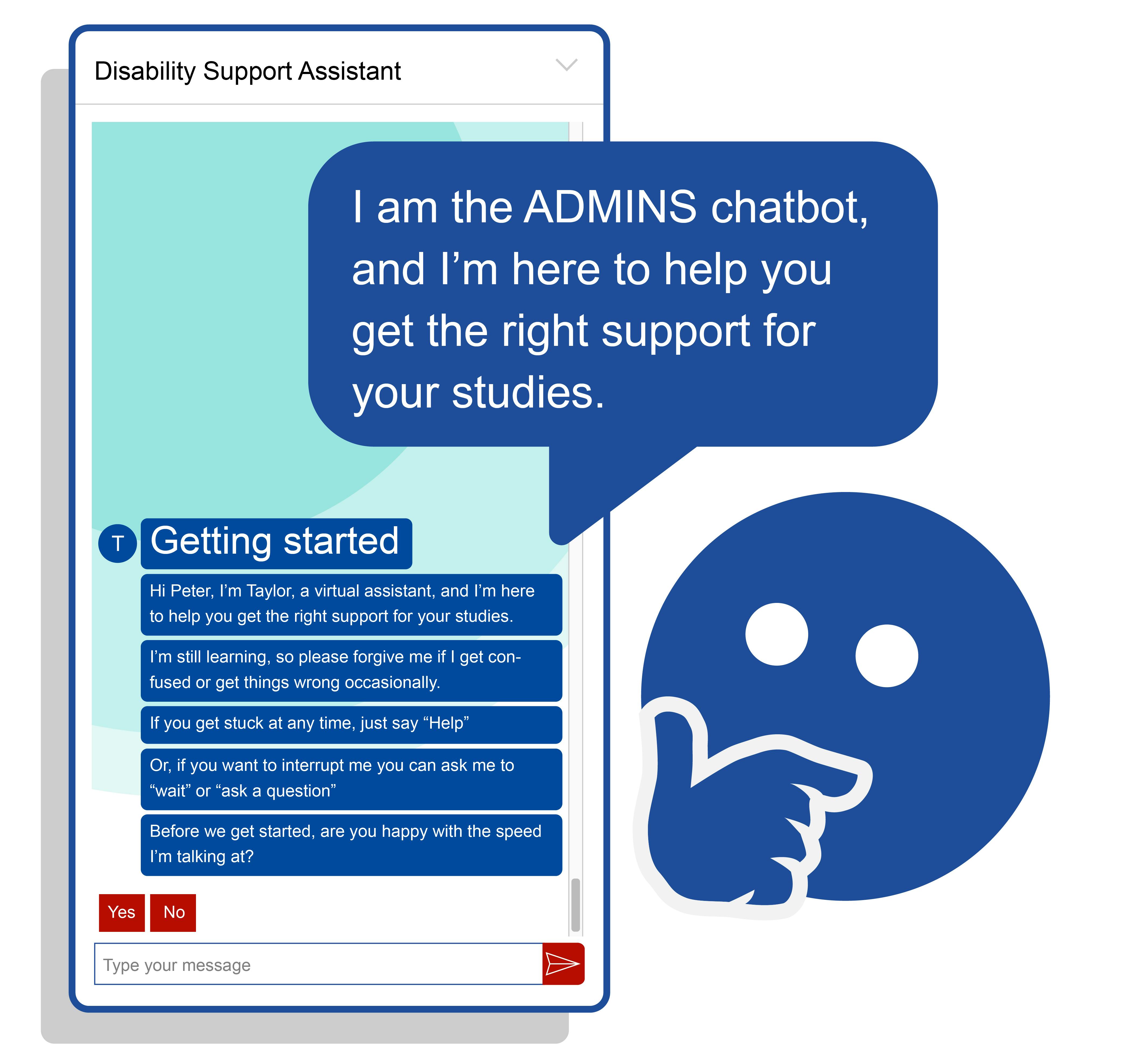Research · Editorial
How the OU’s new chatbot is helping disabled students

The process of disclosing a disability can be a time-consuming and stressful experience. The OU is aiming to improve this process with a chatbot that has been built to support both its students and staff.
The OU’s chatbot, produced as an output of the ADMINS Project, has been developed by educational experts, staff and students at the OU to improve disability disclosure processes for people with disabilities.
The ADMINS chatbot, which has been developed in partnership with Microsoft’s AI for Accessibility initiative, uses innovative technologies (including artificial intelligence) to allow students to disclose their conditions and needs of support through a conversation, rather than submitting information with a traditional form.
Using feedback from OU students who have opted to use a BETA version of the ADMINS chatbot during a trial, educational experts at IET are making improvements to the processes that students use to disclose their disabilities and arrange tailored support related to their studies at The Open University.

Feedback from student consultations give IET experts confidence that the chatbot will provide a more supportive, comfortable option for students to inform the OU about their circumstances, accessibility needs and preferred methods of study.
As well as consultation from OU students, Disability Support Staff have advised educational experts to identify challenges and provide solutions that disabled students are faced with, in the process of disclosing their information.
1. The chatbot guides students through the disclosure process

The challenge of navigating university systems are of the most significant hurdles that students experience when disclosing their conditions.
Research by educational experts at IET has uncovered that the administrative process of submitting institutional disability disclosure forms can be stressful, isolating and time-consuming. In some instances, it can be unclear to students what impact their disabilities might have on their studies, as well as what support is required need, and how students can request support in the disclosure process.
The ADMINS chatbot has been built to guide students through the process of disclosing their disabilities. The chatbot guides students by following a conversation structure (designed by IET experts, OU staff and students), summarizing key information in relation to the student's needs.
2. The chatbot answers user questions about OU study and support
The ADMINS chatbot has been designed with the ability to have conversations with students. It is able to have these conversations due to a built-in intelligence which allows it to respond to students’ questions, give clarification and access to information.
Discussing the chatbot further, Ron Turner, BSC Natural Sciences student at the OU, stated:
“For me personally, the chatbot is easier to use than the disability support form.
“I like that I am able to ask questions from the Chatbot that I am not able to ask when I try to fill in the disability support form. It’s good that the Chatbot is flexible. I prefer to speak to the Chatbot, but I know other students prefer to type.
“The Chatbot shows that the OU is concerned about disabled students. As a disabled student, I was very happy to take part in the project that would make it easier for disabled students to find out more about what is available and become involved with the OU.”
3. Users of the chatbot can choose whether to type or speak
Accessibility is of the utmost importance to IET and The Open Univerity. Students must be able to communicate on their terms. Through the work of the ADMINS project, the OU is leading in the improvement of innovative and accessible practice by-the-way of chatbots in higher education.
The ADMINS chatbot has been developed built to understand both text and speech, offering the flexibility for students to discuss their needs how they prefer.
With the use of leading practices, the chatbot uses speech interpreting technology which allows students to speak into their devices as well as allowing the chatbot to talk back. After processing the speech, the chatbot presents the speech back to the user to ensure that the student's needs and preferences have been logged in a way that the student is happy with.

4. The chatbot allows users to respond at their own pace
In the development of the ADMINS chatbot, IET experts consulted with OU students and disability support specialists to understand the challenges that students experience when disclosing their conditions. From the experience of students and staff, filling out the disclosure form can be time-consuming, causing students to feel overwhelmed, tired and stressed.
Acknowledging this, the chatbot has been built to allow students to respond at their own pace.
The student-staff consultation also identified that the pace of conversation would have to be adaptable to the needs of the student, because it was reported that some students may need more time to process and respond than others and there was no ‘perfect’ pace.
In response to this, the bot was built to be able to speed up or slow down its speech dependant of the preference of the student.
Discussing the chatbot further, Ruth Tudor, Doctoral student of Education at the OU, stated:
“It was a pleasure to be involved in this project. I liked the ethos of student involvement from start to finish. I believe the bot is a good idea and once fully functional will be a valuable addition to the disability disclosure process for students.”
5. The chatbot creates a summary of the conversation for the student to review
At the end of the disclosure discussion, the ADMINS chatbot provides the user with a summary of the conversation. This summary checkpoint allows the student to review their disclosure responses and make any necessary changes.
When the student confirms that they are happy with the information in the disclosure summary, the information is securely summarised and sent directly to an OU Disability Support Advisor who will contact the student to discuss their needs and support options.
Following the project and positive findings of the trial, work will continue through 2021 to examine how to develop and better integrate the chatbot at The Open University, investigating further how to integrate and collaborate leading practices with other universities and institutes across the HE sector.

The project team who worked on the ADMINS chatbot include:
- Dr Tim Coughlan, Senior Lecturer in Education and Human-Computer Interaction, ADMINS Project Lead
- Kate Lister, Lecturer in Education Studies, ADMINS Organisational Process and User Engagement Lead
- Kevin McLeod, Senior Learning and Teaching Technologies Manager, ADMINS Technical Project Manager
- Dr Nick Freear, Educational Technology Developer, ADMINS Chatbot Developer
- Dr Richard Greenwood, Educational Technology Developer, ADMINS Chatbot Developer
- Peter Devine, Educational Technology Designer, ADMINS Chatbot Design consultant
- Paul Maher, Senior Product Development Manager
- Dr Francisco Iniesto, Postdoctoral Research Associate in Technology Enhanced Learning, ADMINS Researcher
To learn more about how a bot like the OU's ADMINS chatbot can help your institution support staff and students, see the ADMINS Project and contact our experts.
People
-
KL
Kate Lister
-
NF
Dr Nick Freear




